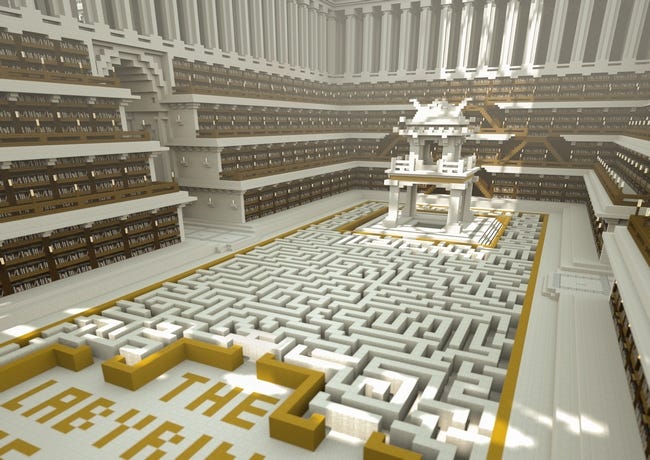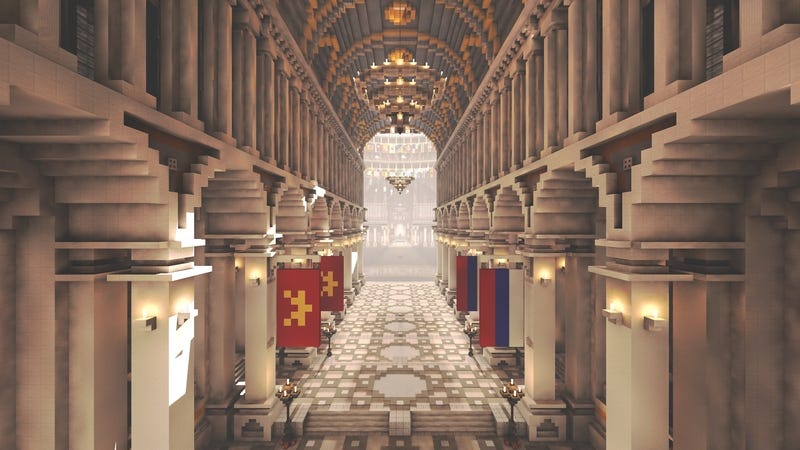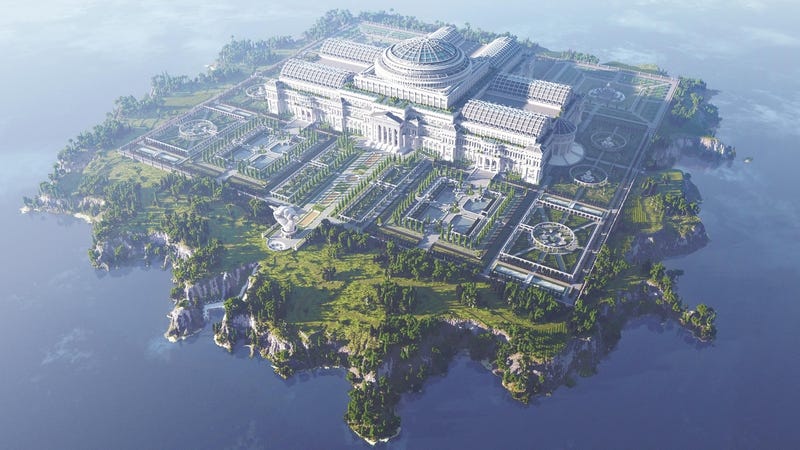Two Libraries: One Imagined by Jorge Luis Borges, One Built in Minecraft
Fictions that carry weight. #literature #knowledge #journalism #censorship #videogame
Welcome back to Artcade, the newsletter you can also play in co-op. Today we’re visiting two buildings so astonishing they’re partially incomprehensible. And that’s where we come in—Daniele “MDM” Mantegna and I—to try to bring a bit of clarity (him) and to sow more confusion (me). Enjoy the read!

Ficciones was first published in 1944. It is a book, but it’s also much more. For starters, it’s made up of short stories, but if it were that simple, I could have just said, “It’s a short-story collection,” and left it at that. Inside, there are pseudo-essays, pseudo-documents, pseudo-realities. I bet you’ve never seen the prefix “pseudo-” used so many times before.
One of these works of art made of words is titled The Library of Babel, and it begins like this:
The universe (which others call the Library) is composed of an indefinite and perhaps infinite number of hexagonal galleries, with vast air shafts between, surrounded by very low railings. From any of the hexagons one can see, interminably, the upper and lower floors. The distribution of the galleries is invariable. Twenty shelves, five long shelves per side, cover all the sides except two; their height, which is the distance from floor to ceiling, scarcely exceeds that of a normal bookcase. One of the free sides leads to a narrow hallway which opens onto another gallery, identical to the first and to all the rest. To the left and right of the hallway there are two very small closets. In the first, one may sleep standing up; in the other, satisfy one's fecal necessities. Also through here passes a spiral stairway, which sinks abysmally and soars upwards to remote distances.
An entire universe shaped like a library, brimming with knowledge so vast it confuses its inhabitants—sometimes elated by the infinite abundance of information at their disposal…
When it was proclaimed that the Library contained all books, the first impression was one of extravagant happiness. All men felt themselves to be the masters of an intact and secret treasure. There was no personal or world problem whose eloquent solution did not exist in some hexagon. The universe was justified, the universe suddenly usurped the unlimited dimensions of hope.
…other times resigned.
For four centuries now men have exhausted the hexagons ... There are official searchers, inquisitors. I have seen them in the performance of their function: they Always arrive extremely tired from their journeys; they speak of a broken stairway which almost killed them; they talk with the librarian of galleries and stairs; sometimes they pick up the nearest volume and leaf through it, looking for infamous words. Obviously, no one expects to discover anything.
As you read on, the events and circumstances affecting the human beings in that strange world aren’t all that different from those affecting us and our even stranger planet. Thankfully, there’s a subtle idea running through the text: that, ultimately, the universe doesn’t really care all that much about what happens to humankind.
Others […] believed that it was fundamental to eliminate useless works. They invaded the hexagons, showed credentials which were not always false, leafed through a volume with displeasure and condemned whole shelves: their hygienic, ascetic furor caused the senseless perdition of millions of books. Their name is execrated, but those who deplore the “treasures” destroyed by this frenzy neglect two notable facts. One: the Library is so enormous that any reduction of human origin is infinitesimal. The other: every copy is unique, irreplaceable, but (since the Library is total) there are always several hundred thousand imperfect facsimiles: works which differ only in a letter or a comma. Counter to general opinion, I venture to suppose that the consequences of the Purifiers’ depredations have been exaggerated by the horror these fanatics produced.
Jorge Luis Borges [1944] The Library of Babel [Ficciones] [Literature]
To introduce the second library in this installment, I’m turning to the wonderful writing of Daniele Mantegna (here’s his IG profile; see the Information Desk below for his newsletter). Daniele is a collector of details, able to observe and get caught up in the world by way of hidden paths. You couldn’t find anyone better to tell you about what’s known as The Uncensored Library, built within Minecraft.
The Uncensored Library is a monumental digital space set up inside Minecraft to host articles and reports banned by repressive governments in various parts of the world. The organization Reporters Without Borders inaugurated it on March 12, 2020—World Day Against Cyber Censorship—after three months of work and with the help of 18 virtual builders who placed more than 12.5 million blocks. The result is a neoclassical structure with remarkable aesthetic detail, where each hall is dedicated to a country where press freedom is severely restricted: Russia, Vietnam, Egypt, Saudi Arabia, Mexico, and others.
Inside this construction, the in-game books don’t contain made-up stories but real articles by persecuted journalists and activists, often translated into English for an international audience. What makes the library so resistant to censorship is precisely its digital nature: the Minecraft world where it resides can be copied, downloaded, and hosted on independent servers in different countries. Not even shutting down one specific server can suppress these censored materials: transferring the saved game file brings the library back to life somewhere else.
What’s most striking is the contrast between the seeming simplicity of a video game and the profound impact of a project aimed at defending truth and freedom of expression. Wandering through these virtual corridors means retracing the work of independent journalists, rediscovering articles erased from the internet, and giving new life to voices someone, somewhere, is trying to silence. In an era when information can move at lightning speed yet also be easily suppressed, The Uncensored Library stands as a powerful example of how digital creativity can serve as both refuge and symbol of resistance.
Mojang Studios (2011) Minecraft [Video Game] [Sandbox] [PlayStation 3/4/5, Xbox 360/One/Series S/X, Microsoft Windows, Nintendo Switch, macOS, Android, iOS, Linux] Xbox Game Studios
Information Desk
The latest article from Memorandum (Daniele’s newsletter) starts precisely with The Uncensored Library and goes on to discuss censorship throughout history and in modern times. Did you know that Animal Crossing was once fertile ground for the resistance in Hong Kong? No? You can read about it here (Italian).
How can you visit The Uncensored Library? How can you support the project? Where can you find more information on each section? These are all great questions, and the most detailed answers can be found on the official website.
What if there was a way to explore the library Borges imagined? There is—it’s on a website. Now that’s what I call lucky.
The creation of The Uncensored Library is a story in itself, which is why there’s a two-minute making-of video that also gives you a peek inside.
My last two coins
It would be nice to have a world without #######. #######, ### ####### #########? # ###### ## ########## ## ## ##### ## ### ####### ## ##### ##### ######, ##### #########, ## ######## #### ## ##### ## #######. #### ####### ## ## ######, # ######, ## ###### ### ######### # ############# ### ###### #### ##### ########## ## ########## ########### # ############ ### ########### # ##### ###########. ## ######## ## #### ####### ###### ##### ######## ###### ######: ######### ## ########### ## ##########. ##### ### #### #######, ciao!







